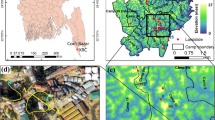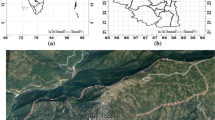Abstract
Among the most landslide prone in the Philippines is the Baguio district, a center of trade, commerce, education and governance. It also has the highest recorded rainfall in the country. Rainfall-induced landslides (RILs) occur yearly and are triggered by rainfall due to southwest monsoon, tropical cyclones and their interactions; and orographic lifting by the Cordillera mountain range. Both natural and human factors contribute to the region’s susceptibility to RIL. Fatalities can reach hundreds, and economic damages may reach billions of dollars per event. The rainfall and reported RIL occurrence were compiled for the period 2000–2013. The characteristics and impact of major RIL such as those instigated by Typhoon Parma in October 2009 are highlighted. Most landslides were associated with tropical cyclones, enhanced monsoon flow and 24-h rainfall that ranged from 73 to 1086 mm, corresponding to average rainfall rates of 3–45 mm per hour. The number of daily-reported landslide incidents ranged from 1 to 41. Slides, debris flows and earth flows were observed as the predominant types. As the observed landslide-triggering rainfall is below or within the range of the observed yearly maximum 24-h rainfall, which is 164–1086 mm, RIL will likely continue to occur annually and pose a major challenge for Baguio. The minimum of 70-mm daily rainfall may serve as a threshold for early landslide advisory. Given the limited number of landslides and analysis of landslide occurrence in relation to other controlling/predisposing factors undertaken, the threshold identified can only be regarded as indicative.







Similar content being viewed by others
References
Balce GR (1980) Geology of the Baguio district and its implication on the tectonic development of the Luzon Central Cordellera. Geol Paleont Southeast Asia 21:265–287
Caine N (1980) The rainfall intensity: duration control of shallow landslides and debris flows. Geografiska Annaler Ser A Phys Geogr 62:23–27
Canao WD (2013) Summary of typhoon damages: CY2006 to CY2013
Castro R (2013) Timeline of disasters in Baguio City
Catane SG, Cabria HB, Tomarong CP Jr, Saturay RM Jr, Zarco MAH, Pioquinto WC (2007) Catastrophic rockslide-debris avalanche at St. Bernard, southern Leyte, Philippines. Landslides 4:85–90
Catane S, Cabria HB, Zarco MH, Saturay RM Jr, Mirasol-Robert AA (2008) The 17 February 2006 Guinsaugon rock slide-debris avalanche, Southern Leyte, Philippines: deposit characteristics and failure mechanism. Bull Eng Geol Environ 67:305–320. doi:10.1007/s10064-008-0120-y
Cayanan EO, Chen T-C, Argete JC, Yen M-C, Prisco ND (2011) The effect of tropical cyclones on southwest monsoon rainfall in the Philippines. J Meteorol Soc Jpn 89:123–139
Cimatu F et al (2001) Typhoon ‘Feria’ isolates Baguio. Manila, Philippines
Cinco TA, Hilario FD, De Guzman RG, Ares ED (2013) Climate trends and projections in the Philippines. 12th National Convention on Statistics, Mandaluyong City, Manila
Crozier MJ (1986) Landslides: causes, consequences and environment. Croom Helm London etc.
Dong K, Neumann CJ (1983) On the relative motion of binary tropical cyclones. Mon Weather Rev 111:945–953. doi:10.1175/1520-0493(1983)111<0945:OTRMOB>2.0.CO;2
Evans S, Guthrie R, Roberts N, Bishop N (2007) The disastrous 17 February 2006 rockslide-debris avalanche on Leyte Island, Philippines: a catastrophic landslide in tropical mountain terrain. Nat Hazards Earth Syst Sci 7:89–101
Finlay P, Fell R, Maguire P (1997) The relationship between the probability of landslide occurrence and rainfall. Can Geotech J 34:811–824
Gordon AH (1973) The Great Philippine floods of 1972. Weather 28:404–415. doi:10.1002/j.1477-8696.1973.tb00793.x
Greene AM, Goddard L (2006) Low-frequency variability of Philippines rainfall
Guo X-j, Cui P, Li Y (2013) Debris flow warning threshold based on antecedent rainfall: a case study in Jiangjia Ravine, Yunnan, China. J Mt Sci 10:305–314
Guzzetti F, Peruccacci S, Rossi M, Stark CP (2008) The rainfall intensity-duration control of shallow landslides and debris flows: an update. Landslides 5:3–17
Henderson RC (1972) Flood victims tell awesome story of Philippines slides
Hilario FD (2011) Climate change projection for the Philippines. East West Center, Honolulu
Hilario F, de Guzman R, Ortega D, Hayman P, Alexander B (2009) El Niño southern oscillation in the Philippines: impacts, forecasts, and risk managements. Philippine J Dev 36:9–34
Hungr O, Leroueil S, Picarelli L (2013) The Varnes classification of landslide types, an update. Landslides 11:167–194. doi:10.1007/s10346-013-0436-y
Jennings AH (1950) World’s greatest observed point rainfalls. American Meteorological Society, USA
Kubota H, Chan JCL (2009) Interdecadal variability of tropical cyclone landfall in the Philippines from 1902 to 2005. Geophys Res Lett. doi:10.1029/2009GL038108
Lagmay AMA et al (2006) Scientists investigate recent Philippine landslide Eos. Trans Am Geophys Union 87:121–124
Lander M, Holland GJ (1993) On the interaction of tropical-cyclone-scale vortices. I: observations. Quart J R Meteorol Soc 119:1347–1361
Larsen MC, Parks JE (1997) How wide is a road? The association of roads and mass-wasting in a forested montane environment. Earth Surf Process Landforms 22:835–848
Lyon B, Camargo SJ (2009) The seasonally-varying influence of ENSO on rainfall and tropical cyclone activity in the Philippines. Clim Dyn 32:125–141. doi:10.1007/s00382-008-0380-z
Lyon B, Cristi H, Verceles ER, Hilario FD, Abastillas R (2006) Seasonal reversal of the ENSO rainfall signal in the Philippines. Geophys Res Lett 33
Mao J, Wu G (2010) Intraseasonal modulation of tropical cyclogenesis in the western North Pacific: a case study. Theoret Appl Climatol 100:397–411
Marques R, Zêzere J, Trigo R, Gaspar J, Trigo I (2008) Rainfall patterns and critical values associated with landslides in Povoação County (São Miguel Island, Azores): relationships with the North Atlantic Oscillation. Hydrol Process 22:478–494
Mines and Geosciences Bureau Geosciences Development Division (2010) Geologic/structural map of Baguio City. Geosciences Development Division
Mines and Geosciences Bureau Lands and Geological Survey Division (2008) Detailed landslide hazard map of Baguio City, Benguet Province, Philippines. Mines and Geosciences Bureau Lands and Geological Survey Division
Morales E, Camaclang M, Reyes G The cherry hills landslide tragedy (2001) Paper presentation at the 2nd Civil Engineering Conference in the Asian Region, Tokyo
National Disaster Coordinating Council (2009a) Final report on Tropical Storm Ondoy (Ketsana) and Typhoon Pepeng (Parma)
National Disaster Coordinating Council (2009b) Situation report no. 28 on Tropical Storm “Ondoy” and Typhoon Pepeng as of 14 October 2009 7:00 p.m
National Disaster Risk Reduction and Management Council (2012) Situation report no. 38 Effects of Typhoon Pablo (Bopha)
National Disaster Risk Reduction and Management Council (2014) Situation report no. 108: Effects of Typhoon “Yolanda” (Haiyan)
National Mapping and Resource Information Authority (1977a) Atok Quadrangle
National Mapping and Resource Information Authority (1977b) Baguio Quadrangle
Orense RP (2011) Slope failures triggered by heavy rainfall. Philippine Eng J 25
PAGASA (2011) Climate change in the Philippines. www.pagasa.dost.gov.ph. Accessed 25 Aug 2011
Peña R (1992) A review of the stratigraphy of Baguio District. J Geol Soc Philippines 47:151–166
Peña R (1998) Further notes on the stratigraphy of the Baguio District. J Geol Soc Philippines 53:141–157
Popescu ME (1994) A suggested method for reporting landslide causes. Bull Int Assoc Eng Geol 50:71–74. doi:10.1007/BF02594958
Punongbayan R, Arboleda R, Bornas M, Abigania M (2000) The 3 August 1999 Cherry hills landslide in Antipolo City. Philippines Landslide News 13:12–15
Sadler JC (1978) Mid-season typhoon development and intensity changes and the tropical upper tropospheric trough. Mon Weather Rev 106:1137–1152
Saldivar-Sali AND (2004) A landslide risk rating system for the Baguio City, Philippines area. Massachusetts Institute of Technology, Massachusetts
Santos JRR (1967) Hydrogeological and mass movement problems of Baguio City and vicinity
Servando NT, Li P-w, Lai ES-t (2003) Near real-time analysis of the wind structure of tropical cyclones typhoon committee. Annual review 2002
Shimokawa S, Iizuka S, Kayahara T, Suzuki S, Murakami T (2011) Fujiwhara effect; the interaction between T0917 and T0918. Natural Disaster Research Report, 45, 23–26. Accepted Nov 25, 2010
Thomas V, Albert JRG, Perez RT (2012) Examination of intense climate-related disasters in Asia-Pacific. Philippine Institute for Development Studies
Vanzi SJ (2001) Feria leaves deaths, destruction in Luzon
Villafuerte MQ II, Matsumoto J (2014) The seasonal role of ENSO and monsoon on the interannual variations of rainfall extremes in the Philippine Geographical reports of Tokyo Metropolitan University 49:23–32
Wang B, Chan JC (2002) How strong ENSO events affect tropical storm activity over the western North Pacific*. J Clim 15:1643–1658
Wu M, Chang W, Leung W (2004) Impacts of El Niño-Southern Oscillation events on tropical cyclone landfalling activity in the western North Pacific. J Clim 17:1419–1428
Yumul GP, Dimalanta CB, Tam TA, Ramos EGL (2008a) Baguio Mineral District: an oceanic arc witness to the geological evolution of northern Luzon. Philippines Island Arc 17:432–442. doi:10.1111/j.1440-1738.2008.00635.x
Yumul GP Jr, Cruz NA, Servando NT, Dimalanta CB (2008b) The meteorologically abnormal year of 2006 and natural disasters in the Philippines. Episodes 31:378
Yumul GP, Cruz NA, Servando NT, Dimalanta CB (2011) Extreme weather events and related disasters in the Philippines, 2004–08: a sign of what climate change will mean? Disasters 35:362–382
Yumul GP Jr, Servando NT, Suerte LO, Magarzo MY, Juguan LV, Dimalanta CB (2012) Tropical cyclone–southwest monsoon interaction and the 2008 floods and landslides in Panay island, central Philippines: meteorological and geological factors. Nat Hazards 62:827–840
Zêzere J, Rodrigues M (2002) Rainfall thresholds for landsliding in Lisbon area (Portugal) landslides. In: Rybar J, Stemberk J, Wagner P (eds) AA Balkema, Lisse, pp 333–338
Websites
Acknowledgments
Data gathering was made possible through research grants from the United Nations World Food Programme and the University of the Philippines Baguio Jubilee Research and Creative Work Grant. Rainfall data acquisition from PAGASA was facilitated by Darleen Gela and Victorino Aquitania of the International Council for Local Environmental Initiatives, Southeast Asia, and Salvador Olinares of PAGASA Baguio. Landslide data acquisition was facilitated by Edilberto Carabbacan and staff of Department of Public Works and Highways, Cordillera Administrative Region, Jose Valera and staff at the Office of Civil Defense-Cordillera Administrative Region, Janice Singiten of Baguio City Disaster Coordinating Council, Ramon Apil of Baguio City Buildings and Architecture Office, and Charles Hamada and staff of the Baguio Midland Courier. X-ray diffraction analysis was conducted by Carmela Tupaz of the National Institute of Geological Sciences. XRD interpretation was enriched by Chelo Pascua of University of the Philippines Baguio. We also thank Andrei Domogo, Alicia Follosco, Ian Jasper Agulo and Rene Escalante of UP Baguio for assistance during fieldwork and Fay Apil of the Mines and Geosciences Bureau-Cordillera Administrative Region and Arthur Saldivar-Sali of Geotecnica Corporation for insights on landslides. The comments from two reviewers improved the quality of the paper.
Author information
Authors and Affiliations
Corresponding author
Rights and permissions
About this article
Cite this article
Nolasco-Javier, D., Kumar, L. & Tengonciang, A.M.P. Rapid appraisal of rainfall threshold and selected landslides in Baguio, Philippines. Nat Hazards 78, 1587–1607 (2015). https://doi.org/10.1007/s11069-015-1790-y
Received:
Accepted:
Published:
Issue Date:
DOI: https://doi.org/10.1007/s11069-015-1790-y




